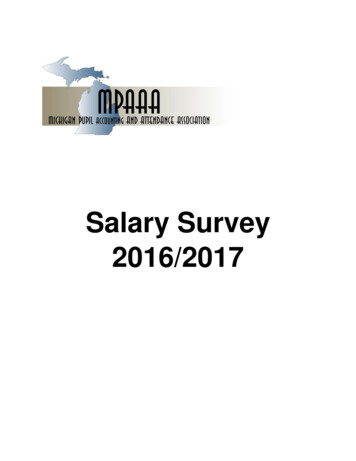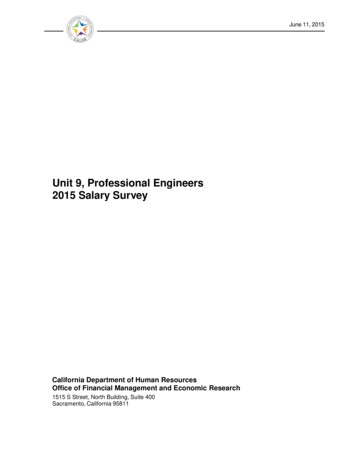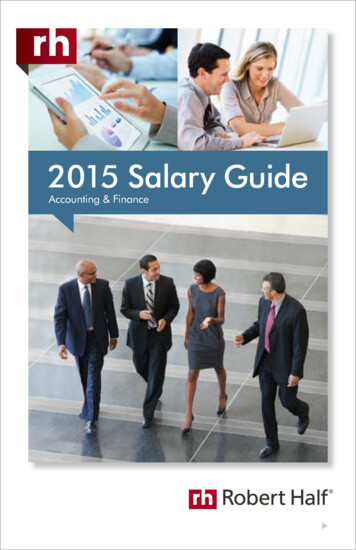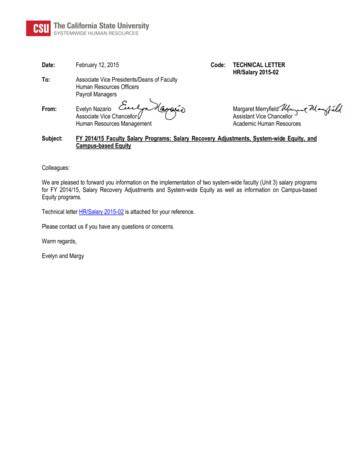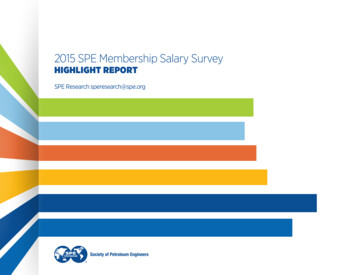
Transcription
2015-16 Faculty Salary StudyExecutive Summary and RecommendationsQualitative AnalysisThe goal of the qualitative analysis was to provide contextual information about how salarydecisions are made, under what circumstances, and based on what arguments. This analysisallows us to delve into more explanatory questions like, why? To what effect? Although salariesare largely affected by structural factors, such as market values of different disciplines,university budgets, and university cultures, they are also the product of social negotiations.Qualitative data analysis focuses on the social processes of salary negotiations.In collecting data for the qualitative portion of this analysis, we used three data collectiontechniques: Salary narratives (N 15), face-to-face interviews with administrators (17 chairs andfour deans), and focus group interviews with associate professors (N 13). The qualitative datareveal several ways that faculty salaries can be impacted before, during, and after each facultymember is hired at NIU.Findings reveal that salaries are usually the product of negotiation, affected by market data,candidates’ portfolios of skills and experience, the culture of the unit and college, availableresources, and the negotiation skills of the faculty members.1. Starting salaries are decided between the unit and the upper administration, based on aseries of agreed-upon market data. A narrow salary range is pre-approved by the upperadministration before each position is approved. Which salary a candidate is offered dependsupon the candidate’s experience; market demand for the candidate; and the chair and/ordean’s philosophy of negotiation.Starting salaries are also the product of negotiation with each new faculty member. Newfaculty have the ability to negotiate several aspects of their contract, including starting salary,start-up packages, workload, and partnership accommodations. Partnership negotiationshave become increasingly commonplace, yet, because there is no university-wide or evencollege-specific set of policies in place at NIU, there is a great deal of variance in how thoseare handled.A new faculty member’s ability to successfully negotiate starting salary is affected by thefollowing factors: years in the field; level of productivity; market value of the discipline/field;marketability of/demand for the particular candidate; effective training in empirically-groundednegotiation; departmental culture/norms; and the experience level of the chair/dean who isfacilitating negotiations.2. Salary increments among existing faculty occur through several mechanisms: raises andoff-cycle increments; promotion; awards, grants, and administrative adjustments; andcompeting outside offers. Problems with each mechanism are addressed.3. Perceived patterns in negotiation: In interviews, close to half of the administratorsindicated a perception that women negotiate less effectively than men. However, more thanhalf of the administrators interviewed argued that women have been trained to negotiateeffectively. The percentage of women in a field may also impact women’s ability to negotiateeffectively. There is not enough racial diversity among the professorate at NIU for subjects
to assess racial/ethnic differences in negotiation, although there was a clear perception thatinternational faculty negotiate effectively.Because salaries are, in large part, the result of social processes that involve negotiation andthe discretion of administrators, those processes should be as transparent as possible.Quantitative AnalysesThe goal of the quantitative analyses of faculty salaries for the 2015-16 academic year is toconduct a comprehensive, transparent, and replicable salary study for tenured and tenure-trackfaculty members at Northern Illinois University. Because it is impossible to control for allpossible characteristics related to productivity, an empirical analysis such as this is only able toidentify instances of potential salary inequities that merit further consideration by the University.The first part of the quantitative analysis, which provides simple descriptive comparisons ofWhite male, female, Asian, Black, and Hispanic faculty members, reveals several instances ofstatistically significant differences in average monthly salary:4. Female, Black, and Hispanic faculty members earn lower monthly salaries than Whitemale faculty members. Across disciplines, we find significant differences between theaverage monthly salary earned by White male faculty members and that of focus groupmembers in the behavioral and social sciences, humanities, and the libraries. Thelargest and most significant differences in average monthly salary occur at the rank offull professor.5. For White male and all female faculty members, years at NIU are positively correlatedwith monthly salary. Years of work at prior academic institutions is positively correlatedwith monthly salary for White male, Asian, and Black faculty members.6. The average monthly salary of female faculty members whose merit scores lie in the topquintiles of their respective college is significantly lower than the average monthly salaryof similar White male faculty members.7. Female faculty members who received a college salary adjustment continue to havesignificantly lower average monthly salaries than their White male peers and Hispanicfaculty members who received a University salary adjustment continue to earn less thanWhite male faculty members.8. For almost all groups of NIU faculty members, the average national monthly salary in thefaculty member’s discipline is significantly greater than the average monthly salaryearned at NIU.Although the findings of the simple comparisons above are suggestive of potential salaryinequities, it is impossible to reach a conclusion concerning possible discriminatory differencesacross groups unless we use regression methods to control for relevant characteristics that mayinfluence productivity. To estimate the effect of sex, race, and Hispanicity on faculty salary, weestimate earnings regressions for faculty members’ monthly salaries. We also performdecomposition analyses to explain the portion of the wage gap that is unrelated to productivitymeasures. The regression and decomposition analyses are performed at the mean as well as atseveral quantiles of the salary distribution.ii
We use independent regression analyses to assess salary inequities in our decompositionanalyses. The decomposition analyses examine average effects and effects across the salarydistribution:9. Using standard regressions estimating effects at the mean of the salary distribution, wefind no empirical evidence that potential discrimination contributes to a wage gapbetween Female, Asian, or Black or Hispanic faculty members and their White malepeers. Indeed, it appears that being female or Asian reduces the wage gap with Whitemales.10. When we consider differing quantiles of the salary distribution, we find evidence ofsalary inequities. In the lowest decile of the salary distribution, unexplained factorsconsistent with discrimination contribute significantly to the salary gaps between Whitemale and both Asian and Black or Hispanic faculty members. At the 25th quantile of thesalary distribution, unexplained factors consistent with discrimination contributesignificantly to the salary gaps between White male and both female and Black orHispanic faculty members. In the highest decile of the salary distribution, unexplainedfactors consistent with discrimination contribute significantly to the salary gap betweenWhite male and Asian faculty members.Although estimates obtained using regression methods are more reliable than simplecomparisons, empirical analyses of salary differentials are inherently limited by the quality ofinformation describing each faculty member’s productivity. Another difficulty is that low numbersof Black and Hispanic faculty members may have caused lack of statistical significance in someof the analyses. For these reasons, the findings described above should be considered to beidentification of potential discrimination that points to the need for further investigation.The last quantitative study of faculty salaries, which analyzed salary data for academic year2010-11 in a pooled regression model, found that gender and ethnicity were not related tofaculty salaries. Our decomposition analyses using independent regressions for each group(female, Asian, Black, and Hispanic) yields similar findings when we consider effects at themean of the salary distribution. However, further analyses across the salary distribution revealspotential salary inequities in several instances.Finally, we examined the extent of salary compression and inversion across the colleges anddepartments. We find that salary compression appears to be widespread across the colleges,but not universal. Instances of salary inversion occur in the College of Business (Departments ofAccountancy and Management) and the College of Engineering and Engineering Technology(Department of Industrial and Systems Engineering). Several other departments havecompression ratios for associate professors that are close to 1.0, indicating serious salarycompression.iii
RecommendationsWe have several recommendations based on the qualitative and quantitative analyses. Datasubstantiating these recommendations are analyzed in the body of this report. Create a university-wide policy or college-specific policies for partnership hiring. Someunits have been very successful and their practices could be used as models for thevarious colleges to adapt, based on their cultures, needs, and expectations of faculty.Other universities can also provide effective models. Instead of using the language of “trailing spouse,” use “partnership hires.” Assess and rectify salary disparities for those who were hired in order to recruit or retaintheir partners, if they were paid less than market value. They are separate employees ofNIU. Be more transparent and consistent with regard to additional pay and non-permanentresource adjustments. There appears to be great variability as to who can access whatadditional resources without any clear communication as to what criteria are used toassess the value of additional work provided by faculty. Being mindful of the service burden on associate professors, discuss workload policiesthat create incentives for service as well as penalties for opting out. Invest in leadership mentoring programs, which identify, train, and support facultyinterested in and skilled at administration. This will help create a structure that rewardsservice and recognizes it as valuable, while also developing a pool of people to shoulderthe heavy administrative workload at NIU. Assess the diversity pipeline issue and devote financial resources to addressing it. The lack of raises is taking a toll on faculty: on morale, on their investment in NIU, andon their career-satisfaction. Dissatisfied faculty may leave the university. Those who stayfind it hard to serve as strong ambassadors for the university—which eventually affectsstudents, current and future donors, and the community at large. Until raises arereinstated on a regular basis, NIU should reconsider large-scale hiring of new faculty(except in dire cases) and consider re-investing in existing faculty who are experiencingsalary compression/inversion. Consider all instances in which the quantitative analyses found evidence of potentialdiscrimination and take necessary steps to rectify any salary inequities. Given that women are less likely to be full professors and that the quantitative analysisindicates that there may be discrimination against female associate professors, werecommend that the University undertake a study of promotion to full professor toascertain if there is sex discrimination present. Undertake a systematic effort to counteract the problem of salary compression andinversion.iv
2015-16 Faculty Salary StudyTable of ContentsExecutive Summary and Recommendations . . . . . . . .i - iv1. Introduction . . . . . . . . . . . . . . . . . . . . . . . . . . . . . . .12. Qualitative Analysis . . . . . . . . . . . . . . . . . . . . . . . . .32-1 Introduction . . . . . . . . . . . . . . . . . . . . . . . . . . . .32-2 Research Methods . . . . . . . . . . . . . . . . . . . . . . .32-3 Analysis Technique . . . . . . . . . . . . . . . . . . . . . .42-4 Findings . . . . . . . . . . . . . . . . . . . . . . . . . . . . . . .52-5 Discussion . . . . . . . . . . . . . . . . . . . . . . . . . . . . .183. Quantitative Analysis . . . . . . . . . . . . . . . . . . . . . . . . .223-1 Introduction . . . . . . . . . . . . . . . . . . . . . . . . . . . .223-2 Description of the 2015-16 Faculty Salary Data . .233-3 Regression Methods . . . . . . . . . . . . . . . . . . . . . . . 303-4 Regression Findings . . . . . . . . . . . . . . . . . . . . . . . 393-5 Salary Compression . . . . . . . . . . . . . . . . . . . . . . .474. References . . . . . . . . . . . . . . . . . . . . . . . . . . . . . . . . . . 70
2015-16 Faculty Salary Study1. IntroductionIn university settings, faculty salaries vary based on multiple considerations that includeacademic discipline, rank, and annual merit scores. Although salaries differ, it is important toassure that these differences are not due to systemic bias toward any group. Toward this end,Northern Illinois University conducted prior studies of faculty salaries in 2008 and 2010. Neitherreport identified systemic bias.Over the last six years, Illinois has experienced significant budgetary challenges and providedNIU less financial support each year. In addition, faculty members have not had cost of livingincreases or merit-based pay increases over this period. In response to these challenges,former CFO Al Phillips and then-Provost Lisa Freeman asked Faculty Senate President GregLong to form a faculty salary taskforce. The study was announced in the April 11, 2016 NorthernStar with an explicit goal of conducting a comprehensive, transparent, and replicable study ofNIU Faculty salaries to investigate any systematic bias (e.g., gender, race, ethnicity) as well asissues of salary compression and inversion.Professors Virginia Wilcox (Economics) and Kristen Myers (Sociology) served as co-chairs ofthe task force. Their backgrounds provided the leadership and knowledge to investigate salaryissues both quantitatively and qualitatively. In addition, the task force membership included 29faculty members from across campus. These individuals provided a diverse membership withexpertise in research design, data analysis, labor relations, and/or NIU policies and procedures.A list of task force members is included in Table 1-1. The Provost’s Office provided twoGraduate Assistants, and they hired an outside firm to transcribe interviews.The remainder of this document will provide an executive summary, as well as technical reportsregarding the quantitative and qualitative data analyses.
Table 1-1: Faculty Salary Task Force MembershipNameCollegeDepartmentTerry BishopJames BurtonBusinessBusinessGena FlynnJoe FlynnLaura JohnsonTodd ReevesLeslie SassoneTom SmithSanthi MuthuswamyChristine NguyenDavid SchroederJane Rose NjueTom PavkovMike EzellBeth GaillardAnne HanleyKristine HuffineJeff KidderMichelle LillyVirginia NaplesKaren SamondsAlecia SantuzziDavid ValentinerSimon WefferYolanda KingLeanne VandecreekJohn SiblikRichard SiegesmundPaula FraszCenter for Black onEngineering and Engin TechnologyEngineering and Engin TechnologyEngineering and Engin TechnologyHealth and Human SciencesHealth and Human SciencesLiberal Arts and SciencesLiberal Arts and SciencesLiberal Arts and SciencesLiberal Arts and SciencesLiberal Arts and SciencesLiberal Arts and SciencesLiberal Arts and SciencesLiberal Arts and SciencesLiberal Arts and SciencesLiberal Arts and SciencesLiberal Arts and SciencesLawUniversity LibrariesVisual and Performing ArtsVisual and Performing ArtsVisual and Performing ArtsMGMTMGMTCenter for ARTDTHED
2. Qualitative Analysis2-1 IntroductionQuantitative methods can tell us whose salaries increase, when they increase, by how much,and how often. These are important questions to answer. Qualitative data can providecontextual information about how salary decisions are made, under what circumstances, andbased on what arguments. This analysis allows us to delve into more explanatory questions like,why? To what effect? Although salaries are largely affected by structural factors, such as marketvalues of different disciplines, university budgets, and university cultures, they are also theproduct of social negotiations. This section of the report analyzes data on the social processesof salary negotiations.Qualitative data were collected for the first faculty salary study in 2005. An external firm washired to conduct seven focus group interviews with faculty. Interviews were designed to capturefaculty perceptions about salary equity. Focus group data with faculty revealed five themes:First, faculty perceived that salaries at NIU were not nationally competitive. Second, facultywanted more institutional recognition of the challenges of excelling at both research andteaching. Third, faculty noted a disconnect between institutional reward systems and facultywork efforts in a context of increasing workload expectations. Fourth, systemic mentoring effortsneeded enhancement. Last, faculty called for increased diversity in leadership, particularly atthe department chair and dean levels. The subsequent salary studies did not employ aqualitative approach.While faculty perceptions of salary equity are important as they reflect and contribute to thecampus climate, we focused qualitative data collection in this study on social processes relatedto faculty salaries. We collected data on factors that affect decisions made by faculty andadministrators, which in turn may impact faculty salaries.2-2 Research MethodsIn collecting data for the qualitative portion of this analysis, we used three data collectiontechniques: Salary narratives, face-to-face interviews with administrators, and focus groupinterviews with associate professors. For the salary narratives, faculty were asked to providetheir starting salaries, and to note every time they had salary increases since being at NIU,including raises, promotions, awards, and retention offers. They also provided their current3
salaries. Faculty were recruited through the Faculty Salary Study steering committee andthrough Faculty Senate. Fifteen narratives were submitted. The goals of this method were tohelp reveal important experiences that positively impact salary. Data collection using thismethod was completed once the data became saturated. The narratives revealed informationthat could be gleaned through quantitative analysis: merit raises matter for faculty salaries.Kristen Myers conducted face-to-face interviews with chairs and deans, across colleges, whohave conducted salary negotiations with faculty. Participants were recruited through emailsolicitations with chairs and deans who had experience with hiring negotiations at NIU.Seventeen chairs and four deans were interviewed. Four colleges were represented (otherswere not included either because their chairs or deans were too new to have experiencenegotiating at NIU, of because they did not respond to requests for interviews).Dr. Jeff Kidder and Kristen Myers conducted focus group interviews with associate professorswho have been in rank for more than 6 years. We recruited participants through departmentchairs, asking for a list of faculty who meet this criterion. Then we contacted each professorthrough email, inviting them to participate. We held three focus groups with 13 people. The goalof these interviews was to explore factors that impeded faculty’s progress toward full professor.Because promotion to full is one major way for faculty to increase their salaries, we wanted tounderstand if there are ways that the university could better facilitate faculty advancement. Weasked questions about the challenges facing associate professors, especially regardingincreased and uneven service loads, mentorship, and support within different units.2-3 Analysis TechniqueAll interviews were transcribed by an external firm. Then written transcripts were uploaded intoNVivo software to facilitate coding. Every interview was coded through a grounded (Charmaz2014) technique. In open coding, all potentially relevant insights were coded, even if they did notseem centrally relevant to the project at hand. This first phase of analysis yielded 39 codes. Notall of these codes remained analytically fruitful as the analysis developed. In axial coding, theinitial codes were re-evaluated. Redundant codes were eliminated. Other codes were mergedso that richer, more conceptual codes were formed. This phase yielded patterns on several keyissues, including ways that salary is positively affected, the importance of candidates’negotiating skills, and the role of administrator discretion in setting starting salaries. In the finalphase of coding, selective coding, relationships between major concepts were explored. This4
phase produced more complex insights into social processes related to salaries. For example,how is gender related to salary negotiation?2-4 FindingsThe data collected reveal several ways that faculty salaries can be impacted before, during, andafter each faculty member is hired at NIU. Salaries are usually the product of negotiation,affected by market data, candidates’ portfolios of skills and experience, the culture of the unitand college, available resources, and the negotiation skills of the faculty members. Whilespecifics vary by the position, the unit, and the college, the overall patterns are similar acrossthe units included in this sample. It is important to note, however, that there is no singlenegotiation strategy that can be generalized, even within one unit. As such, these findings focuson patterns with the caveat that context matters a great deal.A. Salary decisions and negotiations with new hiresStarting salaries are decided between the unit and the upper administration, based on a seriesof data, which we discuss below. These salaries are also the product of negotiation with eachnew faculty member. In fact, new faculty have the ability to negotiate several aspects of theircontract, including starting salary, start-up packages, workload, and partnershipaccommodations.(1) Salary range and starting salaryBefore each faculty position is approved, a salary range must be proposed by the hiring unitand approved by the deans and provost. Salary ranges are typically grounded in marketdata specific to the discipline and/ or sub-discipline of the proposed hire. Typical datasources used to substantiate a proposed salary range include the Oklahoma StateUniversity Salary Study, the Delaware Study, data from departments at peer institutions, anddata from discipline-specific professional associations. Some chairs are also mindful of thesalaries earned by the most recent hires in their department. Not all colleges use the samedata sources or strategies. For example, the College of Business uses data from theInternational Accrediting Body for Business Schools, who conduct an annual salary study ofits 575 members. CBUS’s proposed salary range is derived from the 50-75% percentiles inthis annual study.5
Most proposed ranges are rather narrow. For example, a position may be approved with astarting range of 63,000 to 67,000. Ranges are typically not advertised when the position ismade public. Instead, salaries are advertised as “competitive” and “commensurate withexperience.”Starting salary is constrained by the pre-approved salary range, but it is usually negotiableto an extent. When a top candidate has been selected, the chair makes an offer. Initialsalary offers vary according to several factors: The candidate’s experience. This includes years in the field and professionalproductivity. Typically, the more experienced a candidate, the higher the initial offer. Market demand for the candidate. This factor takes account of competition and marketforces, such as whether the candidate is being highly recruited. Candidates with otheroffers have more leverage than those without offers. Minority candidates are oftenheavily recruited and may have more leverage in the process of negotiation. Some subfields also more marketable than others, particularly in the sciences. The chair and/or dean’s philosophy of negotiation. Interviews revealed that chairs anddeans differ in their perspectives on what figure to use in the initial salary offer. Somestart at the low end of the range and others start and the high end of the range. The “lowend” negotiators argue that they want to leave room for negotiations. The “high end”negotiators recognize that raises are rare and that starting salary is increasinglyimportant in times of fiscal uncertainty.Most chairs expect candidates to try to negotiate their starting salary. Depending on wherethe negotiations begin (low or high end of the range) candidates may have varying degreesof success in increasing starting salary above the initial offer. Highly marketable candidatesmay get offers above the pre-approved range. Most candidates will not. Some candidatesopt out of negotiating and accept the initial offer, sometimes unwittingly accepting the lowend of the range. In those cases, chairs occasionally advise the candidates to “ask formore.”(2) Start-up packagesStart-up packages are more negotiable than base salary. They are temporary rather thanpermanent, with funds that must be spent within two to three years. Depending on the unit,start-up packages may include the following:6
Funds for professional development (e.g. travel money for conferences, data collection,professional memberships, etc.) Funds to hire graduate assistants or other personnel to assist with research Equipment—this is especially important in the sciences. Laboratory or other research spaceStart-up packages are a relatively new part of faculty negotiations at NIU. In the College ofLiberal Arts and Sciences, for example, they were introduced by Chris McCord when hebecame dean. These funds can be the deciding factor for a professor who is debatingwhether or not to come to NIU. They are especially important when starting salary is lowerthan the market, and/or in the context where future salary increases are unlikely.Although some units have standardized their start-up packages, there is a great deal offlexibility with them. Across colleges and units, start-ups range from 1,000 to 250,000.There is a largely standard start-up package of 8000 for faculty in the Humanities andSocial Sciences. This standard makes hiring negotiations more efficient, and it can beamended if the circumstances necessitate that. Start-ups in the natural and physicalsciences can be hundreds of thousands of dollars for equipment and to renovate space.Although they are more flexible, these funds requested still require justification through aspecific research proposal. The use of data is necessary. Some units require faculty toreport back on how the funds were spent and how they benefited them professionally. Usualprocurement rules apply.(3) WorkloadThe standard workload for all academic units at NIU is three 3 credit hours courses persemester, or a 3-3 for the year. Many units have adjusted teaching loads due to researchproductivity, indirect instruction of undergraduate and graduate students, and other forms ofstudent mentorship. In CLAS, units with doctoral programs have lower teaching loads thanthose with Master’s only, etc. The Academic Planning and Procedures Manual (APPM)guarantees all newly hired faculty on the tenure track a reduction of one three (3) credit hourcourse during the first two years of their employment regardless of what unit they are in.However, other workload adjustments can be negotiated during the hiring process. Forexample, Anthropology typically has a 2-2 teaching load, but they offer first year faculty a7
1-1 load. The department of Counseling, Adult, and Higher Education typically has a 3-3load, but new faculty can negotiate a 2-3 teaching load for one year.Other units treat teaching load as non-negotiable, explaining that teaching is a core missionof the university. However, even those units that do not offer course reductions sometimesminimize the number of new courses prepared by new faculty member, which does helpmanage the workload.(4) Partnership accommodationsIncreasingly, faculty candidates require a partnership accommodation in order to accept aposition at NIU. One dean said that this was a “pretty constant phenomenon.” Faculty whohave partners/spouses with PhDs attempt to negotiate tenure track positions, VisitingAssistant Professorships, and instructor positions for them. Because NIU has no officialpolicy or practice regarding partnership hires, these requests are managed on a case-bycase basis. Sometimes, the partner is seeking a position in the same department as thecandidate. In others, the partner is in a different discipline altogether. Hurdles to clear inorder for a successful partnership hire include: Negotiations between the dean and the chair or chairs affected by the hire. Negotiations between two deans, if different colleges are involved. Approval by the provost. Creating buy-in from the faculty of the unit(s) involved in the partnership hire. Managing largely false perceptions within a unit that creating an extra position meanslosing a line. Managing false perceptions that a “trailing spouse” is a less valuable/qualified facultymember.Successful partnership hires require a great deal of investment and effort on the part of thechairs,
A new faculty member's ability to successfully negotiate starting salary is affected by the following factors: years in the field; level of productivity; market value of the discipline/field; . 2015-16 Faculty Salary Study 1. Introduction In university settings, faculty salaries vary based on multiple considerations that include .


